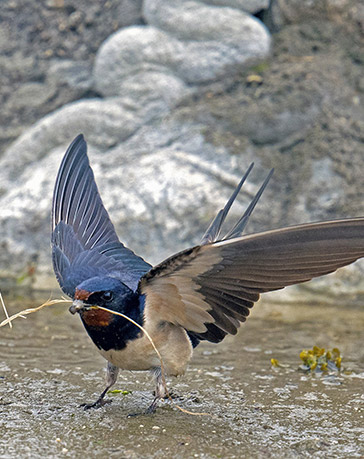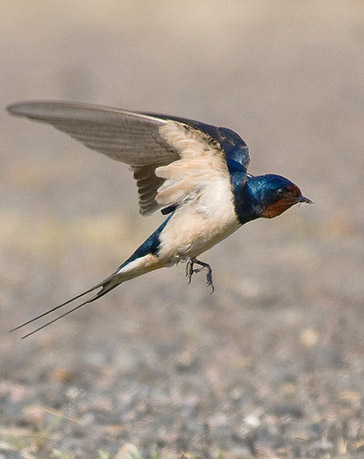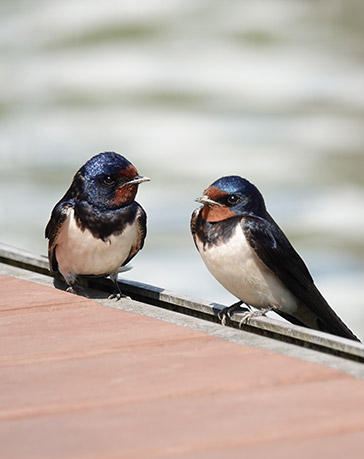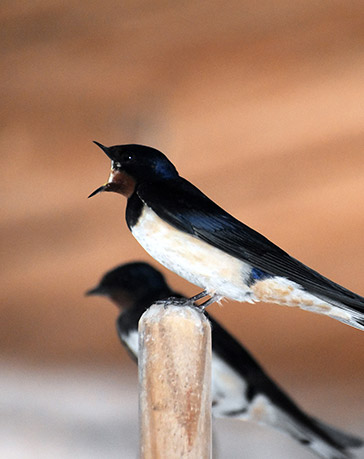BARN SWALLOW (Hirundo rustica)
Barn swallow is a cosmopolitan specie that lives and/or breeds on all continents, except in the polar regions. They breed throughout the Northern Hemisphere except Iceland and spend the winter in most areas of the Southern Hemisphere.
In Greece, when people refer to swallows, they are actually referring to barn swallows; in our country they are summer visitors (from March to October), when large numbers pass through during migration. Sporadically, some remain in winter.


Identification
Adults 17-21 cm (tail extension 3-6.5 cm) and juveniles 14-15 cm.
Black long. The wingspan is 14-15 cm.
Long scissor tail with long extensions at the tips and white markings.
Small.
Large.
Reddish-brown with a wide black-blue stripe underneath
Reddish-brown forehead with a deep dark blue band high on the chest.
Metallic dark blue.
- Females and males are almost identical in appearance.
- Juveniles are much duller with shorter “noses” on the tail.
The barn swallow is a noisy bird, with a relatively loud singing which is a rapid chirp, occasionally interrupted by a hissing sound and ending in a dry rattle.
Voice sample: https://www.xeno-canto.org/species/Hirundo-rustica
It flies fast – at speeds of up to 150 km/h – powerfully with sharp flapping, often low over the ground or water. Its aerial glides are long, slow and fewer than those of the house martin.
It forms fairly large flocks but during nesting it hunts in pairs.
During the day it descends to the ground only during the breeding season, collecting mud for nest construction.
- Supervision or roosting positions: Various exposed locations (cables, roofs, bare branches, etc.). Outside the breeding season they roost in groups in reedbeds. Large numbers of adults and juveniles often in June and July perch on bare ground, airstrips, etc.
- Avoids: densely wooded, steep areas, densely built-up sites.
Hunting / Feeding
They feed in open habitats, grasslands, meadows, ponds, rice fields, fields, rivers and coastal waters. Wetlands and rivers are important foraging grounds for barn swallows as they are full of insects.
Their diet consists of many different species of flying insects such as mosquitoes, bees, wasps, winged ants, moths, mantises, mantis flies, butterflies and dragonflies; only occasionally do they eat a few berries or seeds. The number of successfully growing chicks gives an indication of how healthy the environment is: more food available means there will be more chicks there!
Prey hunting takes place in flight, usually 7-8 m above shallow water or ground, often following feeding animals, people or farm machinery. It often hunts between the legs of grazing animals, but also higher up, at the height of trees. Occasionally, it forages on the water surface, walls or plants. It was probably much rarer before agriculture and ranching.
The barn swallow drinks water in the air, flying low over ponds or rivers and “shoveling” the water with its mouth open. In a similar way, it ‘takes a bath’, submerging itself in water for a moment while flying.
Nesting
- Barn swallows like to nest near large domestic animals such as cattle or horses.
- Before human settlement, the species used to nest in rocks or caves, which is now rare.
- A pair of barn swallows needs up to 1,200 trips to build a nest.
- They easily inhabit artificial nests that resemble their own mud structures.
- Barn swallow nests are easy to locate. They are open nests (open cup shape) made of mud, plant material (straw, grass, seaweed) and feathers.
- Accessible buildings for nesting sites : barns, granaries, stables, large waterways under highways, under eaves and balconies or inside sheds, bridges and other man-made structures. They often use a beam or other man-made structure to support their nest.


- They mate for life
- Reproductive age: 1 year
- Usually there are two laying cycles, from April to August, with 4 to 6 eggs each time
- Young individuals lay fewer eggs than older individuals.
- The eggs incubate for 2 weeks. After hatching, the chicks need another 3 weeks before they can fly away from the nest.
Enemies
In the natural world, there are many predators of barn swallows. That is why each barn swallow makes many eggs, to increase the chances of at least one chick surviving to maturity.
- Predation: Nests are often attacked by rats, mice and snakes that eat the eggs and chicks while predators attack the young; birds of prey such as hawks, owls and eagles can take all the young from a nest without leaving any trace.
- Destruction of nests by other species: House martins and crag martins are known to occasionally occupy the nests of barn swallows, sometimes destroying the eggs in the process.
- Young swallows may fall out of their nests, while other juvenile deaths may be due to intense heat or intense cold, falling nests, etc.
- Nests are susceptible to external pests. Colonies cannot rebuild due to heavy infestations and if pest populations become excessive, they will prematurely abandon their nests leaving the young behind. Characteristic small holes in their wings and tail feathers appear to be caused by bird lice.
- Human causes: Because barn swallows nest in close proximity to humans, nests may fail due to intentional disturbance or destruction or unintentional disturbance by human activities near the nest.
- Constant rainfall over long periods of time makes it difficult for adult swallows to find food, resulting in some deaths.
Migration
European barn swallows usually overwinter in Africa, south of the Sahara.
Curiously, populations from the British Isles and northern Europe spend the winter further south than those from central and southern Europe.
- To see the first swallow of the year is considered a good sign.
- In Russia, songs were written to celebrate their return after the long and cold winter.
- Before the mysteries of bird migration were understood, it was believed that swallows spent their winter buried in the mud of lakes and ponds.
- The “mystery” was solved when a German ornithologist tied small threads, dipped in paint, to the legs of some individuals. The next summer the threads were in place, still painted.
Barn swallow is included in the species listed in Appendix II of the Bern Convention on the Conservation of European Wildlife and Natural Habitats.

